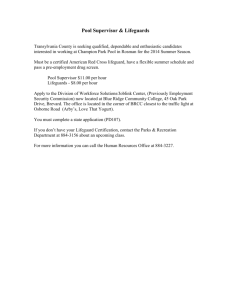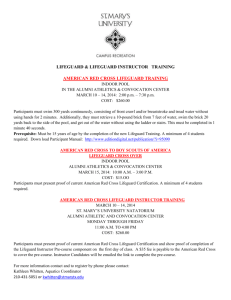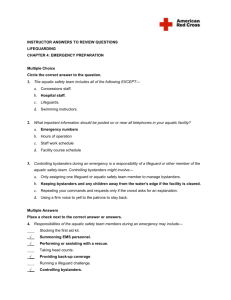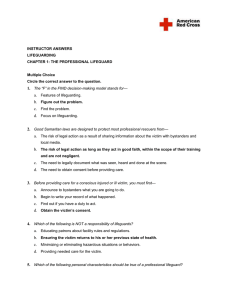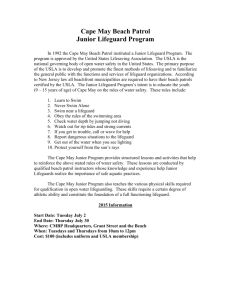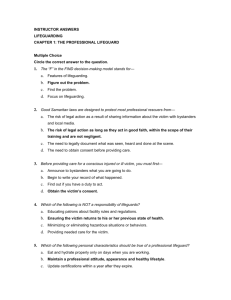East Bay Regional Park District
advertisement
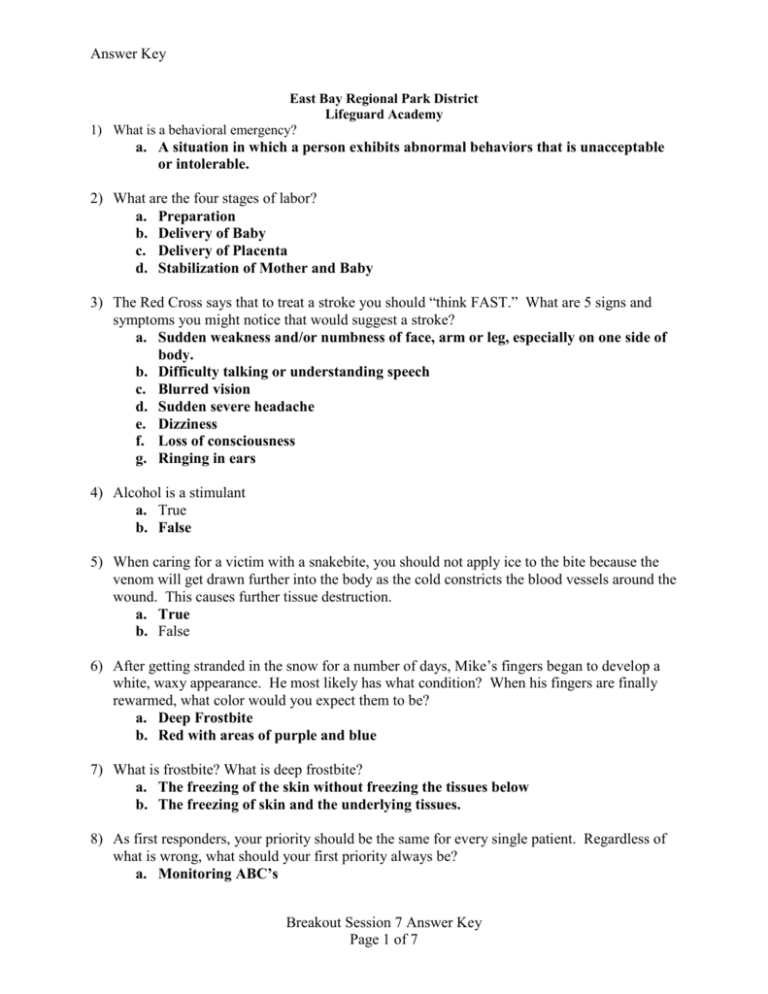
Answer Key East Bay Regional Park District Lifeguard Academy 1) What is a behavioral emergency? a. A situation in which a person exhibits abnormal behaviors that is unacceptable or intolerable. 2) What are the four stages of labor? a. Preparation b. Delivery of Baby c. Delivery of Placenta d. Stabilization of Mother and Baby 3) The Red Cross says that to treat a stroke you should “think FAST.” What are 5 signs and symptoms you might notice that would suggest a stroke? a. Sudden weakness and/or numbness of face, arm or leg, especially on one side of body. b. Difficulty talking or understanding speech c. Blurred vision d. Sudden severe headache e. Dizziness f. Loss of consciousness g. Ringing in ears 4) Alcohol is a stimulant a. True b. False 5) When caring for a victim with a snakebite, you should not apply ice to the bite because the venom will get drawn further into the body as the cold constricts the blood vessels around the wound. This causes further tissue destruction. a. True b. False 6) After getting stranded in the snow for a number of days, Mike’s fingers began to develop a white, waxy appearance. He most likely has what condition? When his fingers are finally rewarmed, what color would you expect them to be? a. Deep Frostbite b. Red with areas of purple and blue 7) What is frostbite? What is deep frostbite? a. The freezing of the skin without freezing the tissues below b. The freezing of skin and the underlying tissues. 8) As first responders, your priority should be the same for every single patient. Regardless of what is wrong, what should your first priority always be? a. Monitoring ABC’s Breakout Session 7 Answer Key Page 1 of 7 Answer Key 9) Why is anaphylaxis a serious condition? a. Your airway could close 10) During birth, occasionally the umbilical cord will protrude from the vagina before the baby does. What is this called? a. Prolapsed Cord 11) First responders should spend as much time as needed trying to determine what is wrong with a patient? a. True b. False 12) In the medical field, what is an aura? Which patients would you most expect to experience an aura? a. This is an unusual sensation or feeling such as a visual hallucination; a strange sound, taste, or smell; or an urgent need to get to safety. b. Seizure Patients 13) You have just been alerted that people have been poisoned by chlorine gas across the lake. You begin responding to offer assistance. What should your first priority be? a. Scene safety 14) As you step outside to get the morning paper, your neighbor, who knows you are a lifeguard for East Bay Regional Parks, runs towards you frantically. She tells you that her husband, who was warming up the car in the garage, is now passed out. You surveyed the scene, put on a pair of gloves; summoned EMS opened the airway and determined the victim was breathing. What should you do next? a. Bring the neighbor outside to fresh air 15) What causes someone to faint? a. The brain is deprived of its normal blood flow. 16) When treating a patient with injuries caused by an insect sting. You have just checked the scene, put on gloves, and checked ABCs? What should you do next? Why should you do each step? a. Examine the skin- this allows you to see if the stinger is still present b. If stinger present, scrape it out-this stops the venom from further injecting itself in the body c. Wash site- this helps prevent infection since the wound is a breach in the skin d. Cover the sting site- this helps prevent infection e. Apply ice to sting site- this helps reduce pain and swelling f. Observe for signs of anaphylaxis- the makes sure the injury does not get worse Use following to answer questions 17-19 During your winter off from lifeguarding, you and a friend travel to Tahoe to go snowboarding. While traveling down an isolated run, you find someone lying in the snow. You check the scene, Breakout Session 7 Answer Key Page 2 of 7 Answer Key obtain consent, and perform an initial assessment. Both you and your friend believe the patient is suffering from a generalized cold emergency. 17) What generalized cold emergency do you think this individual is suffering from? a. Hypothermia 18) Your friend wants to check the patient’s body temperature. They take their glove off and feel the victim’s forehead with the back of their hand. As they are doing this, you tell them that they shouldn’t be checking temperature on the victim’s forehead, but instead should be checking the temperature on the victim’s abdomen. Why should they check there? a. Checking the abdomen allows the rescuer to better gauge the true core temperature. 19) Care for this patient would include removing them from the cold environment, removing wet clothing and gradually rewarming the patient. a. True b. False Use the following to answer questions 20-23 You are working at Shadow Cliffs during a heat wave. The air temperature has hovered around 109 degrees all day with little to no wind. The head lifeguard has set up an alternate station designed to patrol the beach looking for people who may be suffering from a heat related illness. 20) Heat related illnesses set in when the body suffers from ineffective body cooling, causing the body temperature to rapidly rise. a. True b. False 21) What might cause the victim to stop sweating? a. Heavy sweating causes loss of fluid and salt in the body. Over a period of time, the body will produce less sweat. Eventually, sweating will stop. 22) A child comes up to you saying their parent has a headache, is tired and can no longer remember where they are. What do you think might be the problem? a. Later Stages of Heat Exhaustion 23) As you approach the scene, what might you expect the patient’s skin signs to look like? a. Dry, Red and Hot to the Touch Use the following to answer questions 24-30 You are working at Del Valle West Beach and have noticed a woman who appears to be in the later stages of pregnancy lying on the beach. While walking up to the guard station during your break, she calls over to you and says she is scared because her contractions are less than 3 minutes apart and the closest hospital is around 30 minutes away. Breakout Session 7 Answer Key Page 3 of 7 Answer Key 24) What stage of labor do you think she is in? Why? a. She is most likely in stage 1, about to enter stage 2 b. Because contractions are less than 3 minute apart 25) Would it be safe for this woman to drive to the hospital? Why? a. No b. Because childbirth is imminent 26) What might help you determine if you need to help assist with delivery of the baby? a. If crowning is happening 27) As the baby emerges, one would expect to see the head first. What is this called? a. Crowning 28) As you and another lifeguard are assisting with delivering the baby, the other lifeguard tells the mother to focus on the lifeguard chair which is a couple feet away from you. Why do you think he said this? a. It helps the mother cope with the labor and relax 29) During the delivery, it is important to have a clean, dry towel to catch the baby because babies tend to be slippery when they are born. a. True b. False 30) You have just delivered a baby. Unfortunately the baby did not start breathing. What should you do first? If that doesn’t trigger breathing in the baby, what should you do next? a. Flick the bottom of the baby’s foot b. Begin rescue breathing 31) You respond to an emergency and notice the patient has an altered mental status. Friends of the patient say he might have taken some stimulants. The victim might appear very excited, restless, talkative, irritable, combative, or suddenly lose consciousness. 32) What is the most common stimulant? Are they legal? a. Caffeine or Nicotine. b. Yes, they are legal 33) What is the most powerful and publicized stimulant? a. Cocaine 34) When caring for a victim with an altered level of consciousness, what shouldn’t you do? a. Do not give anything to eat or drink b. Do not splash water in the face Breakout Session 7 Answer Key Page 4 of 7 Answer Key 35) When caring for a diabetic emergency, it is important to figure out if the patient is hyperglycemic or hypoglycemic. a. True b. False 36) What should you administer to a hypoglycemic patient who is conscious and able to swallow? What would you administer if the same patient was hyperglycemic? a. Sugar b. Sugar 37) Would diet soda be a good choice to administer to a hypoglycemic individual? Why or why not? a. No b. Because the diet soda has no sugar 38) You come on scene and find a victim that has an altered level of consciousness, change in breathing rate, feels week, is lightheaded, and sweating profusely. Even if you aren’t sure what is wrong with those patients, you know there is a medical emergency because those are all general signs and symptoms of medical emergencies a. True b. False 39) What are the primary responsibilities of the chair stations? a. Water surveillance of assigned zone b. taking preventive actions c. responding to swimmers in need 40) What are the primary responsibilities of the backer station? a. Providing assistance/back up to the lifeguards in the chairs b. assisting with public contacts 41) Lifeguards may routinely carry their cell phones in their fanny pack. Where is this policy found? a. True b. False c. A-6.3 42) What is the purpose of the swim test? a. To provide a consistent way for a lifeguard to determine a person’s swimming ability so the lifeguard can restrict weak swimmers to shallow water 43) What is the District’s most commonly enforced discretionary rule? a. Person must swim with an over-arm stroke in deep water. 44) Lifeguards are allowed to participate in Junior Lifeguard program games when asked by instructors. Where is this policy found? Breakout Session 7 Answer Key Page 5 of 7 Answer Key a. True b. False c. A-7.5 45) What are primary, secondary and tertiary zones? a. Primary: area of water zone that a lifeguard is primarily responsible for. b. Secondary: water areas adjacent to primary zone. c. Tertiary: land areas within sight of lifeguard 46) List 6 factors that may negatively affect a lifeguard’s ability to maintain vigilance over their primary zone. a. Scanning may be monotonous task b. stressful task c. lack of breaks d. heat e. Distractions (cell phones, radios, etc.) f. time of day g. fatigue h. boredom i. intrusion of other job duties 47) What are 4 elements are part of basic coverage principles for swim areas a. Area of responsibility defined b. operational period defined c. protection provided with no break in service d. Working conditions are reasonable and clearly understood. 48) What would double arm grasping or “climbing the ladder” indicate? a. Drowning presentation 49) What are the 3 components of every rescue? a. Recognize and Respond b. contact and control c. signal and save 50) Why was the incident command system created? Who is ultimately responsible for overall management of the incident? a. To promote effective coordination of diverse emergency resources. b. The incident commander. 51) When splinting a leg, you decide to use an anatomic splint. This means you are using… a. The uninjured leg to support the injured leg b. A rigid material like cardboard or wood to support the injured leg in the anatomical position c. A blanket or soft material that can support anatomical body parts in the position they were injured. Breakout Session 7 Answer Key Page 6 of 7 Answer Key 52) If you were to splint an ankle with a soft splint, you would need__________ in order to splint the ankle. a. A rigid piece of cardboard b. A blanket or towel c. The victim’s other ankle 53) When splinting open fractures, lifeguards shouldn’t worry about controlling bleeding. Immobilizing the joint is more important as it will prevent further damage. a. True b. False 54) What are air splints used for? How do you know the splint is properly inflated when using it? a. Air splints are used to immobilize the hand or forearm. b. You should be able to make a slight dent in the surface with your thumb 55) You are called to an emergency where a child broke their forearm. When splinting, you should splint the joints above and below the injury. a. True b. False 56) If the same child in the question above broke their elbow instead. What would you splint? If the elbow were bent, how would you splint it? a. The bone above and below the elbow b. Apply a rigid splint diagonally across the inside of the arm to immobilize bones above and below the elbow. 57) If you get a report that someone broke their shoulder, which bone in the shoulder is broken most frequently. a. Clavicle 58) What would you expect a leg with a broken femur to look like when compared to the uninjured leg? a. It will usually be shorter and turned outward. 59) If you were bandaging a hand, how would you tie the pressure bandage? a. Tie it using a figure eight pattern 60) What is the largest bone in the arm? a. Humerus Breakout Session 7 Answer Key Page 7 of 7
